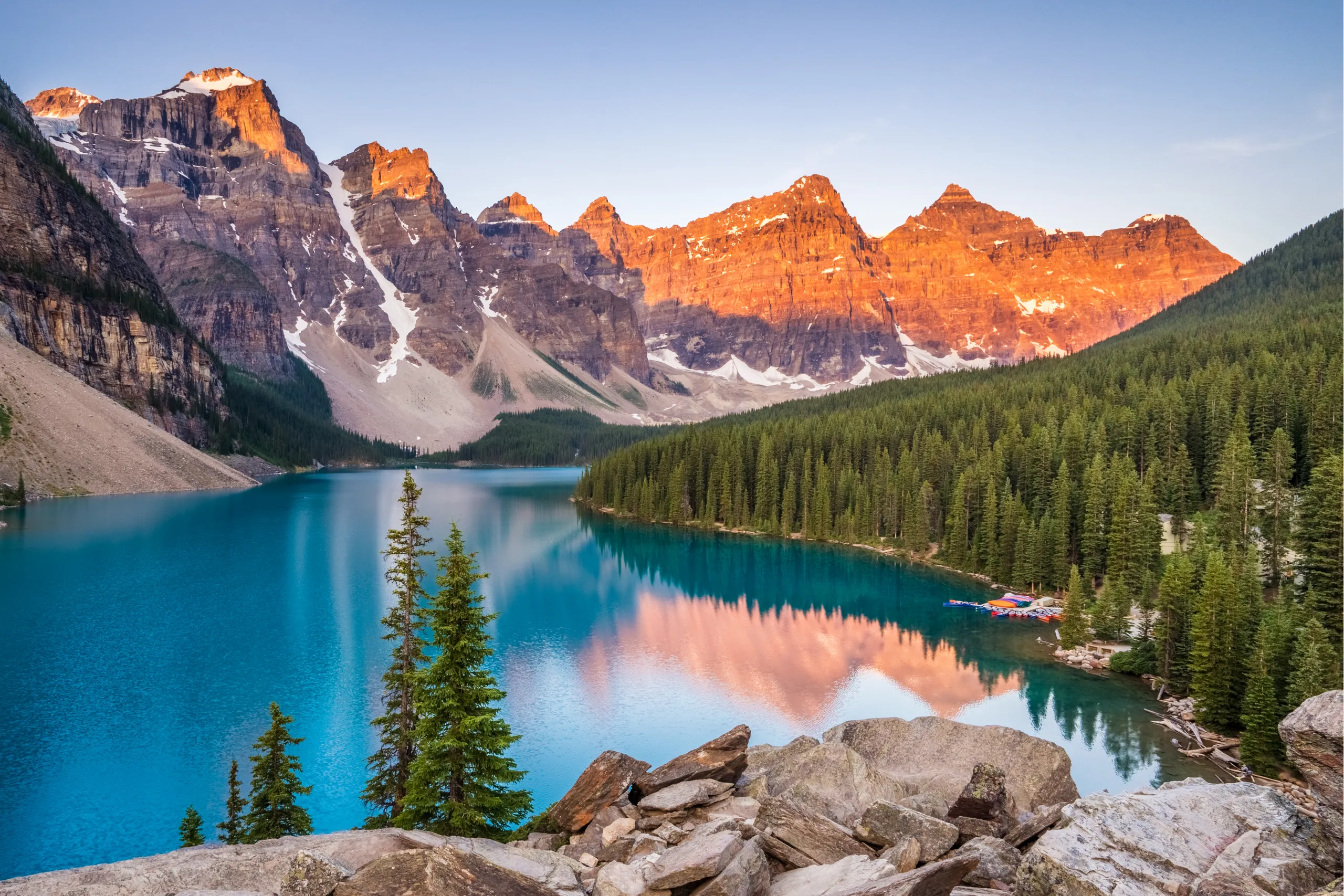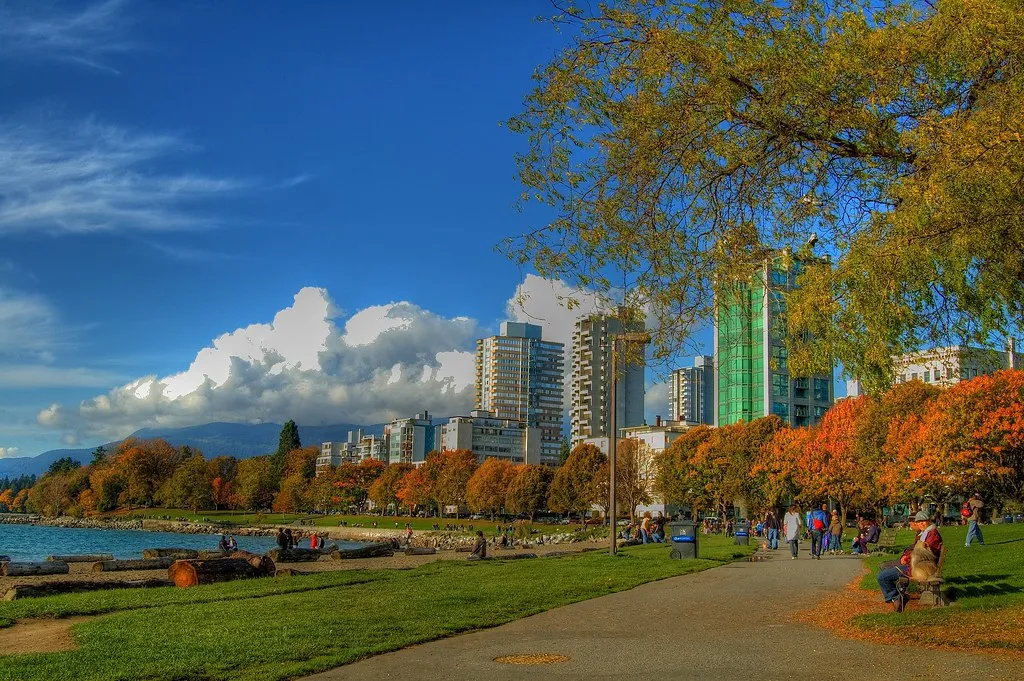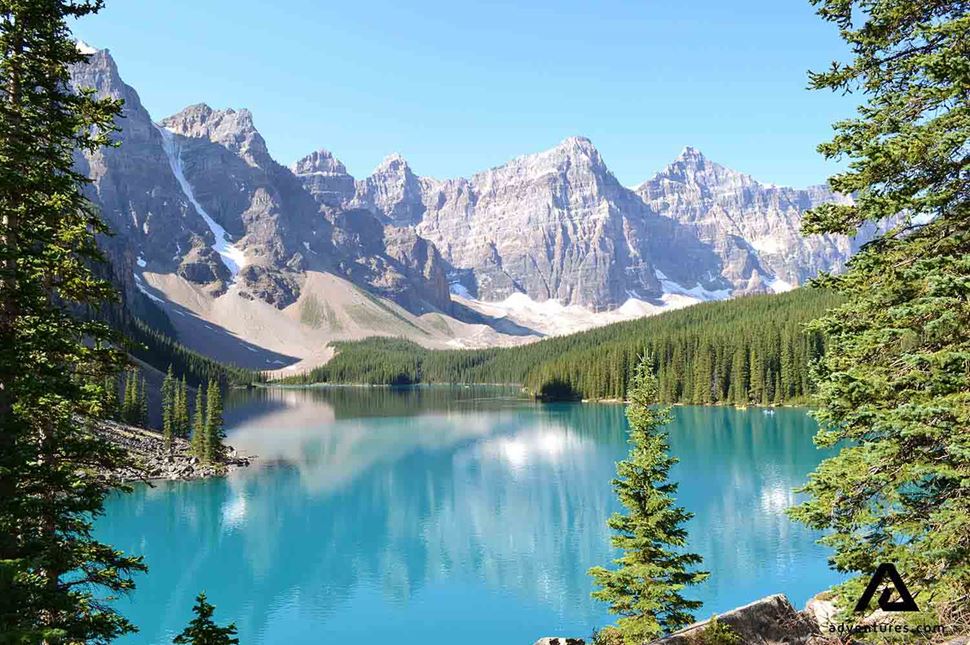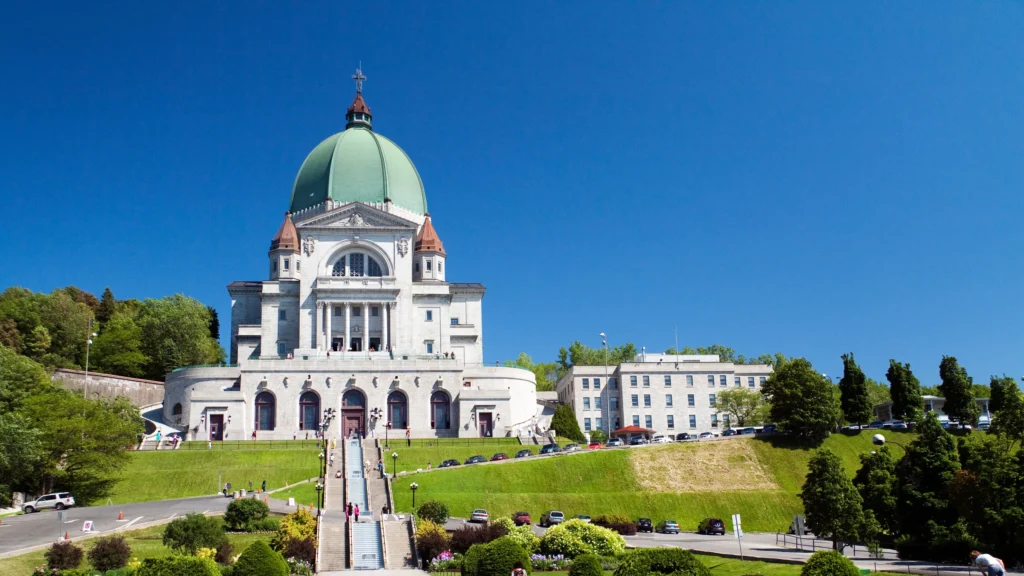Canada isn’t just about towering mountains and rugged coastlines; it also serves up incredible cuisine, boasts vibrant culture, and offers unforgettable road trips filled with moose sightings.

Banff National Park is often considered Canada’s top attraction for good reason. Established in 1885 as Canada’s oldest national park, it perfectly embodies the country’s wild spirit and natural beauty. This vast wilderness balances ruggedness with accessibility, welcoming everyone from casual bus tourists to experienced mountaineers.
The towering peaks of Banff offer endless activities—wildlife watching, hiking, boating, climbing, mountain biking, and skiing. You don’t need to be an outdoor expert to appreciate its charm; the breathtaking scenery alone—from dramatic canyons and alpine wildflower meadows to crystal-clear turquoise lakes like Lake Louise and Moraine Lake, plus lush emerald forests—will captivate any visitor.
One of Banff’s unique appeals is how the wild meets civilization. Imagine spotting grizzly bears near diners sipping cocktails at the elegant Banff Springs Hotel or hikers grabbing ice cream alongside golfers on the green. This fascinating contrast creates a memorable experience for all.
A Brief History
Banff holds deep historical significance. For over 10,000 years, First Nations peoples lived in the area before it became a national park in 1885, making it the world’s third-oldest national park. Banff Town itself hosts four museums, offering rich insights into the region’s natural and cultural history—an uncommon feature for a natural park.
Tickets and Practical Information
Admission fees are C$10 for adults, C$8.70 for seniors, C$20 for families, and free for children under 17. Additional permits may be needed for camping, fires, or fishing. Check the official Banff National Park website for the latest details.
Camping in Banff
The park features 14 frontcountry campgrounds suitable for tents, RVs, and camper vans, mostly open June through mid-September. Tunnel Mountain Village Two and Lake Louise Trailer campgrounds operate year-round. Reservations are recommended and accepted starting in January for select campgrounds, with an extra fee of C$11 plus camping costs. Popular sites fill quickly, so book early.
For campgrounds without reservations, spots are first-come, first-served, so arriving early—around the official 11am checkout time—is best. Banff Park Radio (101.1 FM) updates campground availability. Staying midweek increases your chances of securing a site.
Campsites allow stays of up to 14 nights with up to six people per site. Some campgrounds have entry kiosks for payment; others require self-registration—where you select a site, fill out a registration envelope with your info, and deposit the fee. If arriving late, you can register the next morning or wait for park staff to collect fees.
Campfires are generally permitted at designated fire pits, but a fire permit (C$8.80, including wood) is required. Be mindful of fire restrictions during dry periods.
Hotels in Banff
Despite its size, Banff Town’s hotel rooms are in high demand, and prices tend to be steep, especially in summer. Many visitors opt for camping, hostels, RV rentals, or accommodations in nearby Canmore to save money. No matter your choice, booking well in advance is crucial, particularly during June, July, and August.

Stanley Park, one of North America’s largest urban green spaces, is famed for its stunning forested landscapes and dramatic mountain and oceanfront views. Spanning 400 hectares, this natural haven offers more than just scenic beauty—it’s packed with nature trails, family-friendly attractions, beaches perfect for sunsets, and great places to eat.
Built gradually from 1917 to 1980, the park’s iconic 8.8 km seawall trail is Vancouver’s go-to outdoor spot. This loop trail hugs the water, with spectacular waterfront views on one side and dense forest on the other. Walking the full loop takes about three hours, or you can rent a bike to cover it faster. Note that cyclists and in-line skaters must travel counterclockwise, so if you want to change direction, walking is your option.
Inside the park, explore 25 km of interior trails like Siwash Rock Trail, Rawlings Trail, and the popular Beaver Lake Trail (some trails are pedestrian-only). The Beaver Lake Trail is a favorite since a family of beavers lives there—you might catch them swimming near their den.
The seawall also leads you to top park highlights. Around 1.5 km from the West Georgia Street entrance, you’ll find the vibrant totem poles—remnants of a 1930s plan for a First Nations “theme village.” Recently, exquisitely carved Coast Salish welcome arches were added. For a deeper cultural experience, try a guided walk with Talaysay Tours to learn the full First Nations story.
Further along, visit the Nine O’Clock Gun, which fires nightly at 9 pm, and Lumberman’s Arch, an ideal spot to watch Alaska cruise ships sail by. From here, you can explore the Vancouver Aquarium or continue along the seawall, which becomes wilder and more scenic as you pass beneath the Lions Gate Bridge and face the Pacific Ocean.
Wildlife in Stanley Park
Wildlife enthusiasts will find plenty to enjoy. Near the West Georgia Street entrance, Lost Lagoon is a peaceful bird sanctuary popular for spotting blue herons. The surrounding pathway is also a great place for nature walks.
Deeper in the park’s quieter trails, keep an eye out for wrens, hummingbirds, and lively Douglas squirrels. Visit the Stanley Park Nature House for exhibits on local wildlife, history, and ecology, and ask about guided walks led by knowledgeable volunteers.
Coyotes also inhabit the park, though they tend to avoid humans and aggressive encounters are rare. Still, it’s wise to respect their space and keep a safe distance.
Beaches in Stanley Park
Second Beach on the park’s western side is perfect for families, featuring a playground, an ice cream stand, and a large outdoor swimming pool. Nearby Ceperley Meadows hosts Fresh Air Cinema’s popular free outdoor summer movie screenings.
For a quieter vibe, Third Beach offers a sandy shore with plenty of driftwood to sit on, making it a favorite spot for Vancouverites to unwind on summer evenings.
Opening Hours and Practical Info
Stanley Park is free to enter and open 24/7. You can reach it easily by bus 19 from downtown Vancouver. Bike rentals and attractions like the Vancouver Aquarium require additional fees.
The seawall trail is busiest in summer—arriving early in the morning or late in the evening helps avoid crowds if you want a peaceful nature experience. The aquarium often has queues in summer, so try to visit it early during your visit.

Opened in 1914, the Royal Ontario Museum (ROM) is Canada’s largest natural-history museum and one of the biggest museums in North America. Its striking blend of old and new architecture is sure to provoke strong opinions: the original heritage buildings on Bloor Street contrast dramatically with the 2007 addition known as “the Crystal,” a sharp, angular glass structure that seems to pierce through the older stone façade.
Inside, the museum is just as impressive. When you enter the main hall, look up to see the dazzling mosaic dome ceiling made from over a million Venetian tiles. Created in 1933 by the museum’s first director, the mosaic depicts countless patterns and symbols representing the museum’s vast collection—from a Mayan temple and an Egyptian falcon to a Chinese dragon and a bison.
Galleries and Exhibits
The ROM’s permanent collection features over six million artifacts and specimens, displayed across two main gallery sections: the Natural History Galleries on the 2nd floor, and the World Culture Galleries on the 1st, 3rd, and 4th floors. Highlights include stunning Chinese temple sculptures, a Gallery of Korean Art, and exceptional costume and textile collections. You’ll discover everything from ice-age mammals to hardwood forests, and religious masks.
The First Peoples Art and Culture gallery is particularly notable, showcasing Canada’s Indigenous heritage through a collection of around 1,000 pieces including ceremonial clothing, birch-bark canoes, and fine art. The gallery also features a small theater screening documentaries and hosting live performances, offering contemporary insights into Indigenous cultures. Knowledgeable staff are available on weekdays to answer your questions.
Special Exhibitions and Events
The ROM regularly hosts major temporary exhibitions from around the globe (these require an additional fee). On Fridays, check out the Friday Night Live program—an evening event where the museum opens late, bars are stocked, and DJs spin music for a unique museum dance party experience.
Activities for Kids
The ROM is very family-friendly, with two interactive galleries designed especially for children: the Discovery Gallery and the Family Gallery of Hands-on Biodiversity. Kids can touch shark skulls, explore beaver pelts, dig for dinosaur bones, and walk through simulated bat caves. The cedar crest totem poles carved by Indigenous tribes of British Columbia are also a highlight. Children can enjoy imaginative play by hiding in foxholes or dressing up in historical clothing sourced worldwide. Facilitators are on hand to guide kids and answer their questions.
Tickets and Practical Information
Adult admission: $23
Child admission: $14
Free entry on the third Tuesday evening of every month (arrive after 6 pm to avoid crowds)
Nearest subway stop: Museum station
Free docent-led tours in English and French are offered daily and are highly recommended to better understand the exhibits. Audio tours for select galleries can be downloaded from the ROM’s website. Strollers are available to rent at the coat check.
Top Tips
Visit on the third Tuesday evening for free entry—arrive after 6 pm to avoid the rush.
Take advantage of the free docent-led tours to enrich your visit.
Consider renting a stroller if visiting with young children.
Special exhibitions usually cost extra—check the website ahead to decide if they’re worth your time and money.
Whether you spend a few hours or several days exploring, the ROM offers endless opportunities for discovery and inspiration.

Parc du Mont-Royal is a charming, leafy urban oasis beloved by Montréalers for its scenic wooded slopes and wide grassy meadows. This vibrant park offers a wide variety of outdoor activities year-round — from jogging, cycling, horseback riding, Frisbee tossing, and picnicking in warmer months, to skating, tobogganing, and cross-country skiing in winter. Its stunning views over the city add an extra special touch to any visit.
A Brief History
Locals take pride in their “mountain,” which is actually not a hill—contrary to Oscar Wilde’s cheeky comment when he visited Montréal in the 1880s. The park was designed by Frederick Law Olmsted, the same landscape architect behind New York’s famous Central Park. The idea was championed by residents in the nearby Golden Square Mile who wanted to protect green space from urban development.
Though often mistaken for an extinct volcano, Parc du Mont-Royal’s prominent rock formation is actually the result of ancient magma pushing up through the earth’s crust millions of years ago. This erosion-resistant rock stands 761 feet (232 meters) tall, outlasting the softer terrain around it.
Bird-Watching Highlights
Parc du Mont-Royal is a bird-watcher’s paradise, especially in spring during migratory season. Visitors might spot screech owls, red-shouldered hawks, northern orioles, rose-breasted grosbeaks, bluebirds, olive-sided flycatchers, indigo buntings, and many more species. In winter, the park places bird feeders along the Summit Loop trail (from November to April), attracting hardy bird lovers who enjoy walks to spot local wildlife. For guided bird-watching tours, contact Les Amis de la Montagne at Maison Smith.
Best Lookouts
Belvédère Kondiaronk at Chalet du Mont-Royal
Belvédère Camillien-Houde
Both offer breathtaking panoramic views of Montréal’s skyline and surrounding landscapes — perfect spots for photos or quiet reflection.
Nearby Cemeteries
To the north of the park lie two large cemeteries:
Cimetière Mont-Royal (Protestant and nondenominational)
Cimetière Notre-Dame-des-Neiges (Catholic), known for its notable mausoleums including:
The Pietà Mausoleum, featuring a marble replica of Michelangelo’s famous sculpture
Mausoleums playing solemn music dedicated to figures such as Marguerite Bourgeoys, a beatified nun and teacher
The modern Esther Blondin Mausoleum, housing thousands of crypts and niches
For more about Marguerite Bourgeoys, visit the nearby Chapelle Notre-Dame-de-Bonsecours.
Top Tips for Visiting Parc du Mont-Royal
Plan ahead — pick up maps and info at Chalet du Mont-Royal or Maison Smith, or check online before your visit.
Visit Lac aux Castors for summer boating and winter sports.
Bring binoculars if you’re keen on bird-watching along the feeder trails.
Avoid walking in the park after sunset for safety reasons.
Getting There
Main entrances are on Rue Drummond and Peel (downtown) and Rue Rachel (Plateau neighborhood).
Bus 11 from Mont-Royal metro stop offers easy access.
Parking is available in two lots inside the park.
Whether you’re looking to get active, enjoy nature, or simply soak in spectacular views, Parc du Mont-Royal offers a refreshing green retreat right in the heart of Montréal.

The Museum of Fine Arts in Montréal is a beautifully updated, accessible art haven set within architecturally stunning buildings. It’s a must-see for art lovers, offering a rich collection of paintings, sculptures, decorative arts, furniture, prints, drawings, and photographs spanning centuries.
Art Highlights
European masters like Rembrandt, Picasso, and Monet
Outstanding Canadian art: works by Prudence Heward, Paul Kane, landscapes by the Group of Seven, and abstractions by Martha Townsend and Jean-Paul Riopelle
Temporary exhibits, often exceptional, such as showcases on French fashion designer Thierry Mugler
A strong collection of Inuit and Indigenous artifacts
Decorative treasures like Japanese incense boxes and Victorian chests
The Pavilions
The museum’s vast collection is spread across five architecturally distinct pavilions:
Michal & Renata Hornstein Pavilion (Beaux-Arts style)
Houses World Cultures—from ancient African art to modern Japanese pieces—set within a beautiful marble-covered building.
Liliane & David M Stewart Pavilion
Features a stunning decorative-arts collection, including glass, ceramics, textiles, furniture, and industrial design from around the world.
Michal & Renata Hornstein Pavilion for Peace (opened 2017)
Not to be confused with the first Hornstein Pavilion, this newer space displays 750 works spanning Old Masters to contemporary artists and includes the Michel de la Chenelière International Atelier for Education and Art Therapy.
Claire & Marc Bourgie Pavilion
Located in a renovated 1894 church on Ave du Musée, this pavilion showcases Canadian and Québécois art. The top floor is dedicated to Inuit art and cultural heritage. Don’t miss the Bourgie Concert Hall with its exquisite Tiffany stained-glass windows and live performances.
Jean-Noël Desmarais Pavilion
A modern addition designed by Moshe Safdie across Sherbrooke Street. It exhibits Old and Modern Masters, with works from the Middle Ages through the Renaissance and classical eras to contemporary times. This pavilion connects underground to the Hornstein Pavilion.
Convenience
The pavilions are linked by underground tunnels, so you won’t need to worry about the weather when moving between them. However, some pavilions may occasionally close for reinstallation, so check ahead before your visit.
Tickets and Visiting Tips
Buy timed tickets online in advance. These grants access to the Major Exhibition, Discovery Exhibitions, and permanent collections.
Guided outdoor tours focusing on architecture and sculpture are available for an extra fee.
Tickets are half price on Wednesdays after 5 pm.
Discounts for those under 30; free entry for visitors under 20.
The museum is large, so plan plenty of breaks or consider multiple visits—trying to see everything in one day can be exhausting.
Montréal’s Museum of Fine Arts offers an enriching, inspiring journey through art’s many forms and eras, making it an essential stop for culture seekers.

Montréal’s Notre Dame Basilica is a stunning 19th-century Gothic Revival masterpiece, renowned for its elaborate craftsmanship. The interior dazzles with carved wood, gilded sculptures, painted details, and vibrant stained-glass windows that uniquely depict the city’s history.
The original modest church dates back to 1683.
Architect James O’Donnell was commissioned by the Sulpicians to build what became the largest church north of Mexico, opening in 1829.
O’Donnell converted from Protestantism to Catholicism so he could be buried here; his tomb lies in the crypt.
The basilica is famed for significant events, including Céline Dion’s 1994 wedding and the 2000 state funeral of Pierre Trudeau, attended by Jimmy Carter and Fidel Castro.
Facade: Features three statues — Virgin Mary (Montréal’s patron saint), St John the Baptist (Québec), and St Joseph (Canada).
Interior: Hand-carved wooden pillars and decorations, assembled without nails; gilt stars on deep blue ceiling vaults; altar illuminated in shades of evening sky blues.
Stained Glass: Depicts Montréal’s history rather than biblical scenes, making it unique among churches.
Organ: The 7000-pipe Casavant Frères organ is one of the largest in North America and is played during concerts and festivals. The “Take a Seat at the Organ” tour offers a chance to experience it up close.
Bell: Known as Jean-Baptiste, the nearly 12-ton bell in the West Tower is reputedly the largest bell in North America.
Chapelle du Sacré Cœur: A smaller chapel behind the main altar, rebuilt after a 1978 fire, notable for its floor-to-ceiling bronze altarpiece. A favorite local wedding venue.
Aura Light Show: Though currently suspended, this orchestral light show celebrates the basilica’s beauty with dazzling effects.
Guided tours (about 20 minutes) are included with entry fees, but the basilica is temporarily closed to tourists.
When reopened, longer guided tours are available, including access to the second balcony and crypt areas for an extra fee.
Check the official website for the latest visitor updates.
This basilica offers an unforgettable glimpse into Montréal’s religious and cultural heritage through its awe-inspiring design and storied past.

Lake Louise is renowned for its surreal turquoise waters, framed by jagged mountains and the majestic Victoria Glacier. Its stunning blue hue results from sunlight reflecting off fine glacial silt, known as ‘rock flour,’ suspended in the water.
Length: About 2 km (1.2 miles)
Depth: Approximately 70 m (230 ft)
Water color: Vibrant turquoise caused by glacial silt
Location: Banff National Park, Alberta, Canada
Lakeshore Trail: Walk along the forested northern shore to enjoy spectacular views of Fairview Mountain and Victoria Glacier. This quieter path helps you avoid the busiest spots near the Fairmont Chateau.
Hiking: Challenge yourself with hikes to Lake Agnes Teahouse and the Big Beehive lookout, or longer treks like the Plain of Six Glaciers trail. For experienced hikers, steep climbs up Saddleback Mountain (2,330 m) and Fairview Mountain (2,744 m) offer rewarding panoramas.
Canoeing: Rent a canoe at the Lake Louise Boathouse for a peaceful paddle on the lake, soaking in the tranquility and grandeur of the surroundings.
Nearby Attractions: Explore Moraine Lake and ride the Lake Louise Gondola to see breathtaking vistas from above.
Best times: Early morning or late afternoon when the lake’s colors are at their most vivid.
Winter: The lake freezes into a giant ice rink, transforming the area into a snowy wonderland, though the iconic blue water is hidden under ice.
Park admission: C$10 (adults), C$8.70 (seniors), C$20 (families), free for kids under 17.
Parking: C$11.70 per vehicle at Lake Louise lakeshore.
Additional fees may apply for camping, fire permits, and fishing.
Check the official Banff National Park website for the latest fees and regulations.
Lake Louise village is small, mainly featuring a few hotels, a gas station, and outdoor shops.
Budget options: A popular hostel and a riverside campground.
Luxury stays: The iconic Fairmont Chateau Lake Louise, historic lodges, and cabins offer splurge-worthy comfort and spectacular lakeside settings.
Lake Louise is a must-see for nature lovers, offering a breathtaking blend of serene waters, rugged peaks, and endless outdoor adventures.

Perched on the slopes of Mont-Royal, Oratoire St-Joseph offers commanding views over the Côte-des-Neiges area and northwest Montréal. This grand Renaissance-style basilica, completed in 1960, honors Brother André, a beloved local saint famed for his healing powers.
Largest shrine dedicated to St. Joseph in the world
Completed in 1960 in mid-20th-century Renaissance style
Its huge dome is a landmark visible across northern Montréal
Offers spectacular views of the northern Mont-Royal slope
A humble monk who built a small chapel on the site in 1904
Known for miraculous healings; the basement Votive Chapel holds rows of discarded crutches and walking sticks left by devotees
Upon his death, over a million people paid respects during a six-day vigil
Beatified in 1982 and canonized in 2010
His black granite tomb is in the Votive Chapel; his heart is preserved and displayed in a dedicated upstairs museum
In 1973, Brother André’s heart was stolen from a locked room in the Oratory
Thieves demanded a $50,000 ransom, sparking scandal across Montréal
The heart was recovered mysteriously in 1974, found in a storage locker after a tip to lawyer Frank Shoofey
The ransom was reportedly refused officially, but rumors persist that it was secretly paid
Shoofey’s 1985 unsolved murder added to the mystery
Today, the heart is secured behind a metal grille and a transparent case in the Oratory
Tours and the Oratory Museum are currently suspended
Accessible via bus route 51 and the Snowdon and Côte-des-Neiges Metro stations
Pilgrims often ascend the 300 wooden steps on their knees, praying at every step
Visitors can also use stone stairs or a free shuttle from the base parking lot
Oratoire St-Joseph remains a place of deep faith, fascinating history, and architectural grandeur, blending spirituality with striking views over Montréal.
WhatsApp us